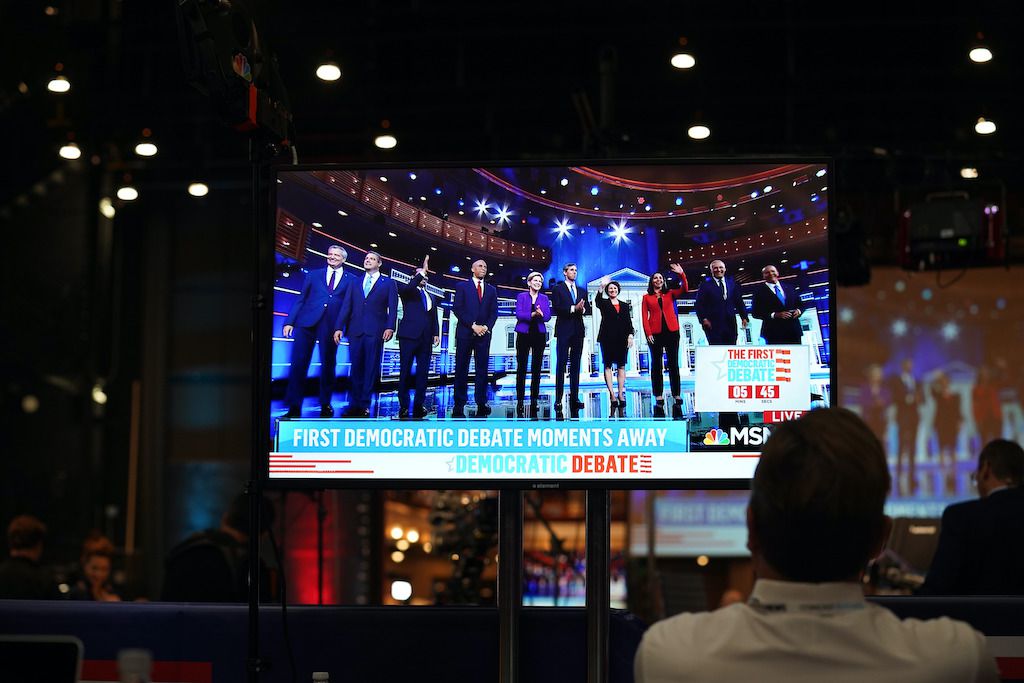The U.S. is set to retain its strength as a global leader
Despite deepening political discord and structural problems, the U.S. can rely on its democratic institutions, its innovative and wealth-generating economy, an active civil society and an unparalleled military to play a dominating global role in the near and mid future.

In a nutshell
- The U.S. is likely to remain a dominant global player
- Its military strategy emphasizes the 'great power competition'
- Economic factors can sap U.S. international strength
This new series of GIS reports examines how effectively countries are ruled and the consequences of governing systems for economies, societies and nations’ development prospects.
In the modern era, the United States has proven itself a resilient power. It features a robust balance of the elements of national power – military, political, diplomatic and economic instruments. Despite the current partisan discord, the dynamics that make the nation an effective global competitor are not likely to change in the near term. However, a shift in direction after the 2020 national elections could impact America’s competitiveness over the long run.
Still the biggest gun
The U.S. is a power with global interests and responsibilities. In that context, its capacity to project military strength is of utmost importance. American forces are homeland-deployed and forward-positioned around the world. Furthermore, the U.S. “globally sources” forces for major operations. In other words, if the country has a significant commitment in one operational theater (e.g., the Middle East), forces might well be drawn both from bases at home and from other parts of the world to act in that region. The ability to operate in all key parts of today’s world – especially Europe, the Middle East, and the Indo-Pacific – is critical for the United States.
The divisions of the U.S. civil rights movement and Vietnam War protests were more disruptive, as was the political conflict during the Watergate scandal.
Since the September 11, 2001 terrorist attacks, the U.S. military has labored to conduct current operations, sustain trained and ready forces, and modernize equipment simultaneously. Budgetary restrictions following the 2007 recession further strained the capabilities and capacity of U.S. armed forces. In the last few years, forces’ readiness has rebounded while the scale of operational deployments has declined. Modernization has accelerated, particularly in naval and aerospace forces. The Pentagon has made additional commitments to defensive and offensive operations in space and cyberspace.
Meanwhile, U.S. military strategy has begun to emphasize the “great power competition,” signaling America’s commitment to its global role. The U.S. will likely sustain investment in defenses, although funding for nuclear modernization and the triad of nuclear delivery systems remains controversial.

Relative domestic calm
The foundation of American political power is an effective separation of power and independent executive, legislative, and judiciary arms of the federal government. While current affairs in Washington are notable for the sharp levels of partisan strife, including an effort to impeach the sitting president, this partisan division is not evenly reflected across the country, nor is the level of discord as high as in recent history.
The divisions of the U.S. civil rights movement (1954-1968) and Vietnam War protests (1964-1975) were far more disruptive, as was the political conflict during the Watergate scandal (1972-1974) of President Richard Nixon’s era. Unrest was also higher than today during the waning years of George W. Bush’s presidency (2001-2009) with their virulent anti-war protests and anger over the government’s response to Hurricane Katrina. Massive demonstrations, so common in the past, have largely disappeared from America’s streets.
Despite the relative calm of the polity, the national political parties are increasingly strident in their rhetoric. The rising popularity of leftist viewpoints among the mainstream political candidates may be contributing to this. The federal judiciary is also experiencing significant change. While the branch is functionally independent, the president has the authority to appoint judges and justices of the Supreme Court of the United States with the advice and consent of the U.S. Senate, the Congress’s upper chamber.
As of October 2019, the Senate confirmed 157 judicial appointees nominated by President Trump, including two associate justices of the Supreme Court and 43 judges for the United States Courts of Appeals. This record number of appointments will no doubt give the judiciary a more conservative bent for years to come.
Facts & figures
U.S. governance: History and structure
The United States of America (the U.S.) is a federal constitutional republic of 50 states and 14 dependent areas. It originated after Britain's American colonies broke with the mother country in 1776 and were recognized as a new nation following the Treaty of Paris in 1783. During the 19th and 20th centuries, 37 new states were added to the original 13 as the country expanded across the North American continent and acquired several overseas possessions.
The capital, Washington D.C. (District of Columbia), is named after the first U.S. president George Washington (1732-1799).
The U.S. Constitution, drafted between July and September 1787, ratified on June 21, 1788, effective as of March 4, 1789, originally comprising seven articles, has been amended 27 times; it delineates the national frame of government.
Executive branch
- The president is both chief of state and head of government. The cabinet is appointed by the president and approved by the Senate
- President and vice president are indirectly elected on the same ballot by the Electoral College of electors chosen from each state; they serve a four-year term and are eligible for a second term
- The elections were last held on November 8, 2016; the next will take place on November 3, 2020
Legislative branch
- The U.S. bicameral Congress consists of the Senate and the House of Representatives
- The Senate has 100 seats; two members are directly elected in each of the 50 state constituencies by simple majority (except in Georgia and Louisiana which require an absolute majority vote with a second-round if needed); senators serve six-year terms with one-third of membership renewed every two years
- The House of Representatives has 435 seats; members are directly elected in single-seat constituencies by simple majority (except in Georgia, which requires an absolute majority vote with a second round if needed); representatives serve two-year terms
- In addition to the regular House of Representatives, six nonvoting delegates are elected from the District of Columbia and the U.S. territories of American Samoa, Guam, Puerto Rico, the Northern Mariana Islands and the Virgin Islands. The delegates from these single-seat constituencies are directly elected by simple majority to serve two-year terms (except for the resident commissioner of Puerto Rico who serves a four-year term); the delegates and the resident commissioner function in every respect as members of Congress, except that they are denied a vote on the final disposition of legislation on the House floor (a “full floor” House vote)
- The last elections to both chambers of Congress were held on November 6, 2018, with the next one scheduled for November 3, 2020
Judicial branch
- The U.S. legal system is based on English common law at the federal level. State legal systems are based on common law, except Louisiana, whose law is based on Napoleonic civil code. Another notable feature of the American system is judicial review of legislative acts.
- The U.S. courts consist of the federal and state court systems; although each is responsible for hearing certain types of cases, neither is entirely independent of the other, and the court systems often interact
- The U.S. Supreme Court consists of nine justices – the chief justice and eight associate justices. Nominated and appointed by the president, with the advice and consent of the Senate, Supreme Court justices serve for life
- In addition, the U.S. Court of Appeal for the Federal District and 12 regional appeals courts; 94 federal district courts in 50 states and territories are subordinate to the court system.
Source: CIA World Factbook, BEA
Moreover, since both the Democratic and Republican parties tend to nominate sharply partisan candidates for the presidency, the outcome of the elections could alter the political character of American governance. Neither is likely to sweep the presidency and both houses of Congress cleanly. There is a possibility that one or both major parties, based on the results of the election, could fracture and produce major new political parties, injecting new uncertainties into American politics.
Most experts believe that the basic tenets of U.S. foreign policy are unlikely to shift as a result of the national elections.
Conversely, it is also possible that following 2020, one or both parties will gravitate toward more centrist candidates. In any case, a certain divisiveness is bound to persist post-2020 but is unlikely to undermine the strength of American political will in a significant way.
Myths of isolationism
Despite persistent claims that U.S. foreign policy would become increasingly isolationist under President Trump and that the U.S. would eschew traditional allies and international organizations, there is little substantive evidence these predictions have borne out. The U.S. commitment to NATO, for example, is as strong as ever. In the Indo-Pacific, Washington has looked to strengthen alliances with initiatives such as the “Quad,” the U.S.-India-Japan-Australia cooperation. Traditional U.S. partnerships with the Middle East, including Israel, Egypt, and Saudi Arabia, remain robust.
Thus far, foreign policy has not been significantly addressed in the presidential campaign. Many experts believe that the basic tenets of U.S. foreign policy are unlikely to shift as a result of the national elections. The notion of “great power competition” enjoys broad bipartisan support, as does continued engagement in critical strategic areas including Europe, the Middle East and the Indo-Pacific.
Scenarios
In terms of economics, the U.S. remains one of the most powerful, productive and innovative countries in the world. The American economy continues to feature solid growth, low unemployment, continued wage increases and low inflation. Several areas, including energy (where the U.S. has become a net exporter of petroleum products), are particularly strong. The U.S. attracts a significant share of global foreign direct investment. Likewise, U.S. investments and engagement remain highly prized by other countries.
On the other hand, in the near term, U.S. trade policy remains one area of uncertainty. Congress has not yet implemented the U.S.-Mexico-Canada free trade agreement. The future of trade talks with China and U.S. tariff policies remain unclear. Also, the U.S. national debt continues to grow. In the long term, the deficit, inadequate infrastructure investment and mounting entitlement and pension spending could adversely impact America’s military might and constrain its capacity to deal with fluctuations in the global economy. In the short term, however, the U.S. economic output looks quite healthy.
The most likely scenario is that the U.S. will continue to be a global leader in the near term. Even if the national elections bring dramatic results in 2020, it is unlikely that any single political party will control all the levers of government. If those in power seek new radical policies, it is doubtful the measures will be wholly and speedily adopted. The trajectory of overall foreign and security policy looks like it will remain generally consistent. Meanwhile, the strength of the U.S. economy will continue giving the American superpower a competitive advantage on the global stage.







